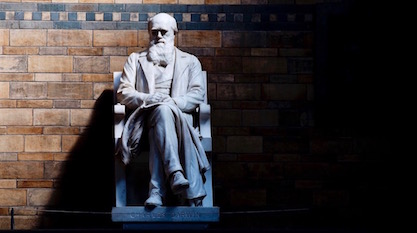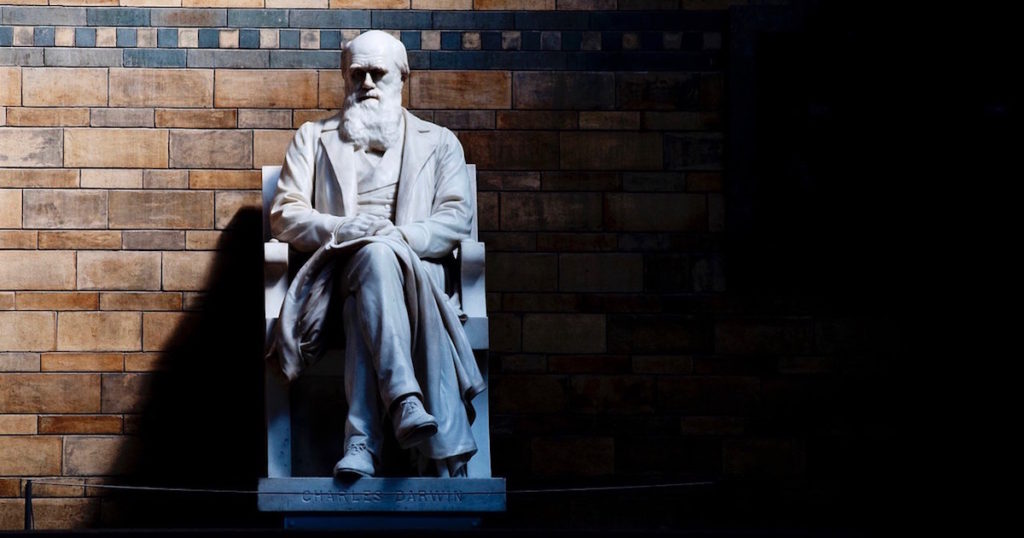 Evolution
Evolution
 Faith & Science
Faith & Science
 Intelligent Design
Intelligent Design
Darwin’s Silver Chair


In The Chronicles of Narnia, C. S. Lewis tells the story of two children and an adult “Marsh-wiggle” who descend deep into a maze of dreary underground caverns to rescue Prince Rilian, son of King Caspian. Eventually they happen upon a friendly knight who explains that the underworld is really a fine place to call home, and its ruler is a wonderful queen worthy of devotion. He has just one problem. Every night he falls under an evil spell, during which he raves like an irredeemable lunatic. Fortunately, he hasn’t hurt himself or anyone else during these rabid spells, he explains, because every evening the good queen binds him to a silver chair for the duration of the fit.
Soon enough the explorers get to witness one of these spells. But it doesn’t play out as expected. The knight does grow distraught, but he doesn’t rave like an unhinged maniac. Instead, he maintains that in fact it’s during the day that he is under the queen’s spell, and the spell only lifts at night. He further insists that the silver chair, far from protecting him, is the very thing that gradually reasserts the evil spell over him. Until it does, he remembers everything. He remembers that the queen is his enemy. He remembers that he hates a life lived away from the sun. And he remembers that he is the son of a king — indeed, he is the very prince they have come to rescue, Prince Rilian.
To break the spell for good, they must loose him from the silver chair and destroy it.
C. S. Lewis was an agnostic before he became a Christian, so he understood the spell of unbelief. In this Narnia novel, The Silver Chair, and in the character of Prince Rilian, Lewis gives us a young man who, under the evil queen’s spell, is like the modern man who has ceased to believe there is anything beyond our material world. Both Rilian and the modern materialist live away from the light, and imagine that such a place is the very place to be. Both, too, forget that they are the offspring of royalty and are called back to the father’s kingdom — the one to the king of Narnia, the other to the King of the universe.
And for each, there are moments when the spell lifts, if only briefly. For the materialist, something whispers to him — perhaps as only a passing sense, triggered by a stunning mountain vista, the love of a mother for her child, an act of heroism from a stranger — and for a fleeting moment he recognizes that here is something that cannot honestly be reduced to mere atoms or glands or fanciful stories of evolution and survival advantage.
In Lewis’s story, Prince Rilian needs to destroy the silver chair to break the spell. For many today caught in the spell of materialism, Darwinism is the silver chair. It’s a belief system that prevents them from seeing the powerful evidence of design in life, evidence that points to something more than matter, to a great immaterial intelligence who created both life and the universe.
How the Darwinist Got His Blinders
In their more candid moments, some leading lights in the evolutionary community admit that the Darwinian worldview comes complete with a set of blinders. They even urge the wearing of the blinders. The great biophysicist Francis Crick, for example, said, “Biologists must constantly keep in mind that what they see was not designed, but rather evolved.”1
Harvard geneticist Richard Lewontin was even more explicit. In an essay he wrote for The New York Review of Books, he defined science as ruling out, by definition, the possibility of God intelligently designing life — never mind that belief in a rational, orderly cosmic Creator was the soil from which modern science sprang. Here is Lewontin in his own words:
Our willingness to accept scientific claims that are against common sense is the key to an understanding of the real struggle between science and the supernatural. We take the side of science in spite of the patent absurdity of some of its constructs, in spite of its failure to fulfill many of its extravagant promises of health and life, in spite of the tolerance of the scientific community for unsubstantiated just-so stories, because we have a prior commitment, a commitment to materialism. It is not that the methods and institutions of science somehow compel us to accept a material explanation of the phenomenal world, but, on the contrary, that we are forced by our a priori adherence to material causes to create an apparatus of investigation and a set of concepts that produce material explanations, no matter how counter-intuitive, no matter how mystifying to the uninitiated.2
What claims could Lewontin have had in mind that, as he put it, “are against common sense,” patently absurd, and held up by little more than “unsubstantiated just-so stories” akin to Victorian author Rudyard Kipling’s fanciful children’s tales about how the leopard got his spots or the camel his hump? We can only guess what Lewontin had in mind, but it’s not hard to think of a few worthy candidates.
Just-So Stories
Maybe Lewontin had in mind any of the many evolutionary stories that sound almost comically similar to Rudyard Kipling’s just-so stories for children — evolutionary stories explaining how, for instance, the bird got its wings, or the bat its sonar. The evolutionist notes how a given feature would have been useful for survival and reproduction, sketches out a small handful of vaguely described intermediates, and then calls it good.
Actually, the vaguely sketched intermediates often aren’t even mentioned. Just the bare mention of a survival advantage is considered good enough. Thus, humans evolved cooperativeness because it helped us survive and thrive better in a hostile world. What about the uncooperative, violent streak in many men? Oh well, our ancestors evolved that because it helped us eliminate competitors, seize women, and pass on our genes to future generations. Yes, just so.
In no case do they detail a series of plausible genetic mutations over many generations that together could have built up the enormous amount of new biological information essential to producing the bat’s sonar or the bird’s wing or some other bio-engineering marvel, with each evolutionary step along the way being a fit and functional form able to survive and reproduce. That part is left to faith and hazy imagination.
The Multiverse Hypothesis
Another just-so story would be the multiverse hypothesis. On this view, our universe’s laws and constants are exquisitely fine-tuned to allow for life not because a designing intelligence fine-tuned them for that purpose, as even some Nobel Prize-winning scientists have suggested (Arno Penzias, Charles Townes). No, according to this materialist just-so story, there must exist an unseen multiverse generator and trillions of other universes, all undetectable, and we’re just one of the lucky ones with the right physical laws and constants for life. Otherwise, we would have to let a divine foot in the cosmic door, and we can’t have that.
The Fossil Record
Or maybe Lewontin had in mind the materialist explanation of the fossil record. Even committed evolutionists such as Harvard paleontologist Stephen Jay Gould admit that the pattern of the fossil record is marked by the sudden appearance of fundamentally new biological forms, followed by long periods of stasis. That’s the opposite of the pattern that mainstream evolutionary theory predicts. Darwinian evolution sees the history of life as a gradually branching tree, with one form very slowly diverging into various daughter forms, and those in turn very gradually diverging into yet other forms, until eventually there is a major architectural difference between two forms widely separated on the tree of life — between, say, a horse and a squid. Instead, we get the sudden appearance of radically distinct forms, and then those major body plans persist in the fossil record for millions of years, relatively unchanged.
Oh, well, the fossil record is incomplete, evolutionists note, and it almost always just happens to be incomplete in exactly the places that would otherwise show this history of a gradual, branching evolutionary tree of life.
Yes, just so — but not so very satisfying, even to many evolutionists. “The absence of fossil evidence for intermediary stages between major transitions in organic design,” wrote Gould, “indeed our inability, even in our imagination, to construct functional intermediates in many cases, has been a persistent and nagging problem for gradualistic accounts of evolution.”3
The Divine Foot & the Birth of Science
Maybe these are some of the just-so stories Lewontin had in mind. In any case, he’s saying that scientists should, on principle, refuse to consider intelligent design, even if it means clinging to a “patent absurdity,” as he put it.
Lewontin isn’t alone. For many, the stricture against considering intelligent design seems reasonable and defensible. They cite the danger that if intelligent design is an explanatory option, if we let “a divine foot in the door,” it will kill scientific investigation. That is, if researchers encounter a mystery they cannot explain, and if they aren’t restricted to material explanations, won’t they tend to just throw up their hands and say, “God did it”? Well, not if the history of science is any indication.
Modern science was first developed by Christians, thinkers who believed in a God who created the first living organisms, the first plants, the first animals, the first humans. At the same time, they believed this God could accomplish a particular creative work in a way they wouldn’t expect, meaning that observation and experimentation were key to discovering the truth about how God actually did it.
That proved to be the right attitude to fuel discovery. The historical sciences, including origins science, are an affair of competing explanations. We have a set of clues about a mysterious past event. We try to dig up additional clues and explain the mystery. Which hypothesis best explains the set of clues before us? Scientists open to both material and intelligent causes are free to consider multiple options. So, for instance, scientists want to try to explain the origin of life on earth. Maybe God simply fine-tuned the laws of nature so that nature could evolve the first living things without further direct input from him. Let’s look at the evidence and see, says the scientist open to design.
Or maybe life on earth originated from a combination of both natural evolutionary processes that God set in motion and some direct additional bio-engineering on his part. So, maybe our solar system, planet, and atmosphere evolved to the point where they contained the right mix of chemicals on the surface of the Earth along with an oxygen-rich atmosphere, and then from within this now life-friendly environment, God assembled the RNA, DNA, specific genetic information, and cellular architecture needed for the first self-reproducing cell. The theistic scientist can be open to any of the above options, and follow the evidence where it leads. But to do that, he must first loose himself from the cords binding him to the chair of dogmatic Darwinian materialism.
Notes:
- Francis Crick, What Mad Pursuit (Basic Books, 1988), 138.
- Richard Lewontin, “Billions and Billions of Demons,” review of The Demon Haunted World: Science as a Candle in the Dark by Carl Sagan, New York Review of Books (Jan. 9, 1997).
- Stephen Jay Gould, “Is a New and General Theory of Evolution Emerging?” Paleobiology (1980).
Photo credit: CGP Grey via Flickr.
Editor’s note: A version of this article appears in Salvo 52. It is published here with the permission of Jonathan Witt.
